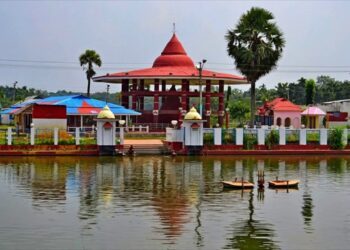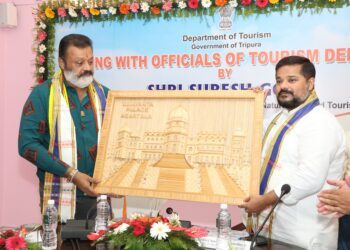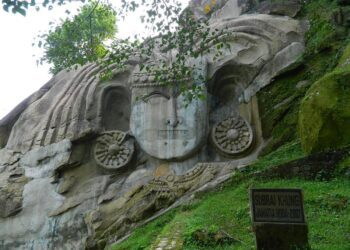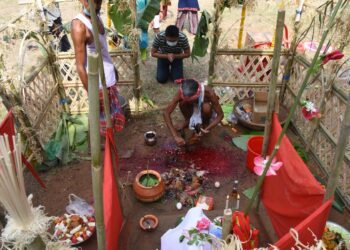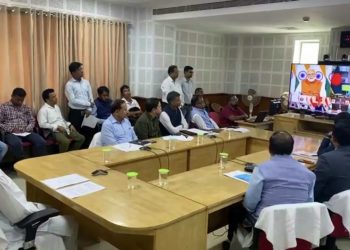Nestled on the steep banks of the Gomati River in the Indian state of Tripura, Chabimura, also known as Chakwrakma or Chakrakma, is an extraordinary site of archaeological and natural splendor. This hidden gem, adorned with magnificent rock carvings, offers an enchanting journey into the heart of Tripura’s rich history and breathtaking landscapes. As we traverse the dense forests and sail along the serene river, let us unravel the mysteries and marvels of Chabimura.
A Journey Through Time and Nature
Situated 82 km from Tripura’s capital, Agartala, and just 7.5 km from Amarpur, Chabimura captivates visitors with its colossal rock-cut images of deities such as Shiva, Vishnu, Kartika, Mahisasura Mardini Durga, and other gods and goddesses. The journey to Chabimura begins with a picturesque boat ride from Rangamati in Amarpur, guides travellers through a narrow gorge bordered by verdant hills. As the boat meanders along the river, the lush greenery and tranquil waters create an ambiance reminiscent of the Amazon rainforest, immersing visitors in nature’s untouched beauty.
The Mesmerising Rock Carvings
Chabimura’s allure lies in its intricate rock carvings, which adorn the steep mountain faces. These carvings, made of light yellow sandstone, date back to the eighth century and showcase the artistic prowess of ancient sculptors. The first panel, known as Panchadevata, features images of Shiva, Vishnu, Kartikeya, Ganesha, and Devi Shakti, each with their respective vahanas (vehicles). Measuring approximately 9 meters by 5 meters, this panel sets the tone for the remarkable artistry that follows.
Further downstream, the second panel reveals an image of Brishabahana Shiva holding a damru (drum). However, the pièce de résistance of Chabimura is the colossal 13-meter-high image of Goddess Durga in her fierce Mahisasura Mardini Avatar, locally known as Devi Chakrama. With ten hands and a hairdo of serpents, this depiction of Durga is both awe-inspiring and formidable. Her right leg firmly placed on the buffalo demon Mahisasur, while her left leg rests on the back of a lion, showcasing her divine power and strength.
Legends and Myths of Chabimura
Chabimura is shrouded in intriguing legends and myths, adding an air of mystery to its already enchanting landscape. One such legend tells the tale of King Chichingfa, who is said to have hidden his treasures in a cave guarded by a gigantic python. The cave, located after a peculiar bend in the river, is believed to house a waterfall and remains largely unexplored due to the local belief that it is protected by supernatural forces.
Another fascinating story involves Princess Hirabati, the daughter of King Chichingfa, who was abducted by a white elephant. Two brothers, Rangia and Fateh, heroically rescued the princess after a fierce battle with the elephant. In gratitude, the king bestowed Hirabati’s hand in marriage to Fateh and revealed the location of his hidden treasure. However, the king warned them of the wrath of Devi Chakrama if they ventured into the cave after dusk. To this day, locals heed this warning and avoid the cave after sunset.
Experiencing Chabimura
A visit to Chabimura is not just about witnessing the ancient rock carvings but also about immersing oneself in the serene and untouched beauty of the region. The boat journey itself is a highlight, offering an opportunity to observe the diverse avian species that inhabit the area. Ornithologists and nature enthusiasts will find this region a treasure trove of birdlife, adding to the overall allure of the trip.
The eerie silence, broken only by the rustling of leaves and the calls of birds, creates a tranquil atmosphere as the boat glides through the Gomati River. The dense forests on either side enhance the feeling of seclusion, making it a perfect escape from the hustle and bustle of city life.
Practical Information for Visitors
For those planning to explore Chabimura, here are some practical details to ensure a smooth and enjoyable visit:
– Boat Charges: The boat ride costs Rs150 per person, with each boat accommodating up to 10 people. If you prefer a private experience, you can hire the entire boat for Rs1500, although skilled bargaining can reduce the cost to around Rs1100-1200. The boat journey typically takes about an hour.
– Cottages: While overnight stays are not permitted, cottages can be rented for day use between 9 AM and 5 PM at a rate of Rs200 per hour.
Guides: Hiring a guide is recommended to enhance your experience and gain deeper insights into the history and significance of the site. Guide charges are Rs100 per hour.
How to Reach: The primary approach to Chabimura is via the Udaipur-Amarpur state highway. From Udaipur, a bus ride to Amarpur (26 km) followed by a 10 km journey to Debtamura Hills will bring you to the starting point of your adventure.
Preserving the Heritage
Despite its immense potential for tourism, Chabimura remains relatively unknown and underdeveloped. Efforts are needed to preserve this archaeological wonder and promote it as a significant tourist destination. The local self-help group managing the boat rides is a commendable initiative, but further support from the government and tourism authorities is essential.
The existing rock panels are uncared for, and proper excavation might reveal even more hidden treasures. By promoting Chabimura, we can ensure that this unique blend of history and natural beauty receives the recognition and protection it deserves.
Conclusion
Chabimura, with its enigmatic rock carvings, lush forests, and serene river, offers an unparalleled journey into the past. The legends and myths surrounding the place add an element of intrigue, making it a captivating destination for history enthusiasts and nature lovers alike. As we navigate through the Gomati River and explore the ancient carvings, we are reminded of the rich cultural heritage that lies hidden in the remote corners of our world.
Let Chabimura enchant you with its beauty and mystery. Plan your visit to this hidden gem of Tripura and immerse yourself in a journey that promises to be both awe-inspiring and unforgettable.



